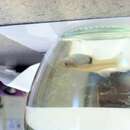Diagnostic Description
provided by Fishbase
Origin of dorsal fin opposite 7th anal ray. Length of anal base much less than half distance from caudal. 8 horizontal scale rows between back and abdomen. Ventrals terminate immediately before anal fin. Pelvic fins reach ventrals.
Diseases and Parasites
provided by Fishbase
Rhabdochona Infestation 6. Parasitic infestations (protozoa, worms, etc.)
Life Cycle
provided by Fishbase
The species is viviparous (Ref. 5258). Internal fertilization is possible because the anal fin of the male is modified into a copulatory organ. The females carries about 30 alevins and gestation lasts for a period of 24 days (Ref. 6348) to a month (Ref. 30578).
Migration
provided by Fishbase
Potamodromous. Migrating within streams, migratory in rivers, e.g. Saliminus, Moxostoma, Labeo. Migrations should be cyclical and predictable and cover more than 100 km.
Morphology
provided by Fishbase
Dorsal spines (total): 0; Dorsal soft rays (total): 7 - 9; Analspines: 0; Analsoft rays: 9 - 10
Trophic Strategy
provided by Fishbase
Inhabits standing to slow-flowing water; most common in vegetated ponds and lakes, backwaters and quiet pools of streams (Ref. 5723). Most abundant in lower reaches of streams (Ref. 44091). Frequents brackish water. Feeds on insects, zooplankton and detritus. Used as live food for carnivorous aquarium fishes (Ref. 5723).
Biology
provided by Fishbase
Most abundant in lower reaches of streams (Ref. 44091). Adults inhabit standing to slow-flowing water; most common in vegetated ponds and lakes, backwaters and quiet pools of streams. Found frequently in brackish water (Ref. 5258). Pelagic and surface predatory fish (Ref. 94816). Feed on zooplankton, small insects and detritus (Ref. 5258, 10294). Used as live food for carnivorous aquarium fishes. Viviparous (Ref. 5258, 30578). Effective in mosquito control and widely introduced, but found to compete with indigenous fish and to upset the ecological balance (Ref. 6351).
Importance
provided by Fishbase
fisheries: minor commercial; aquarium: commercial

